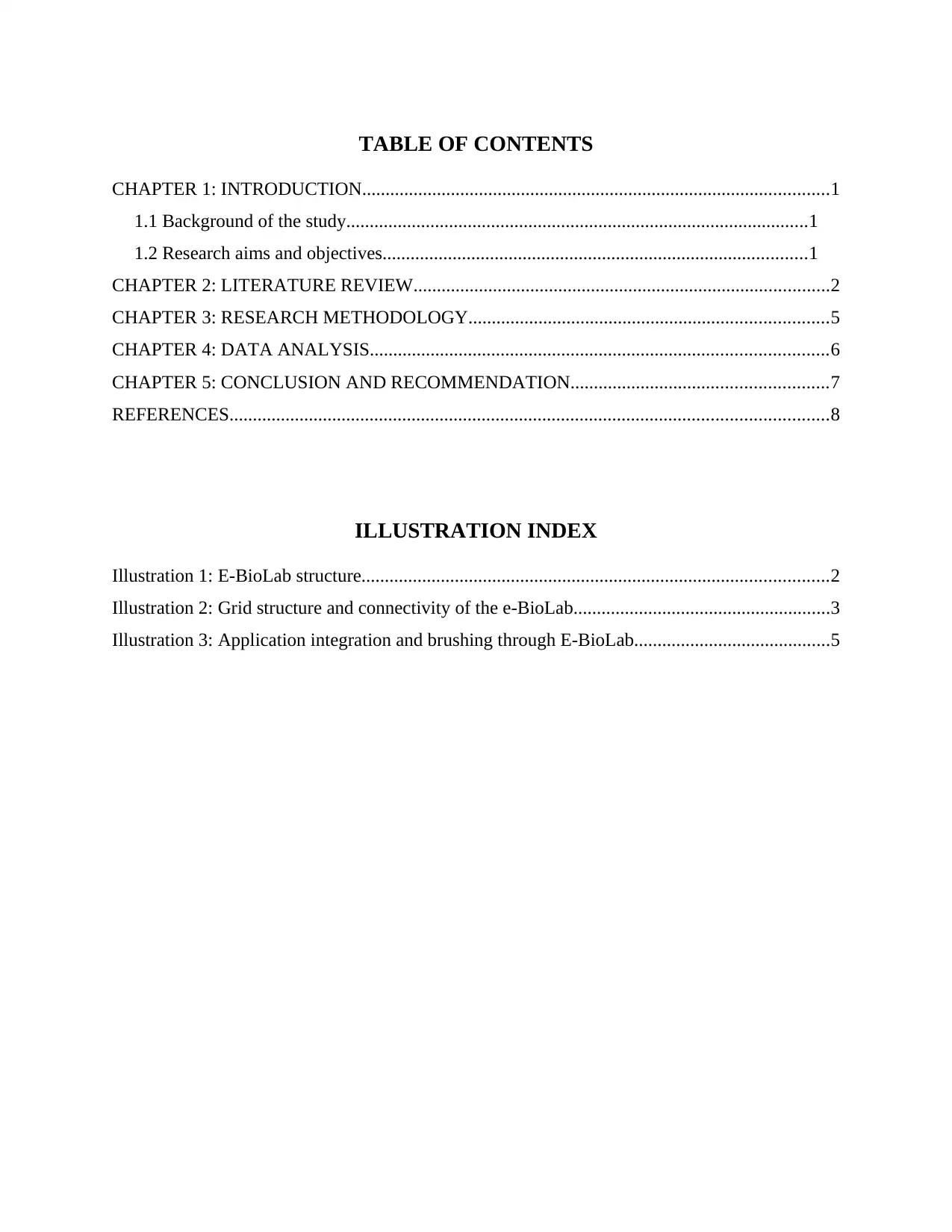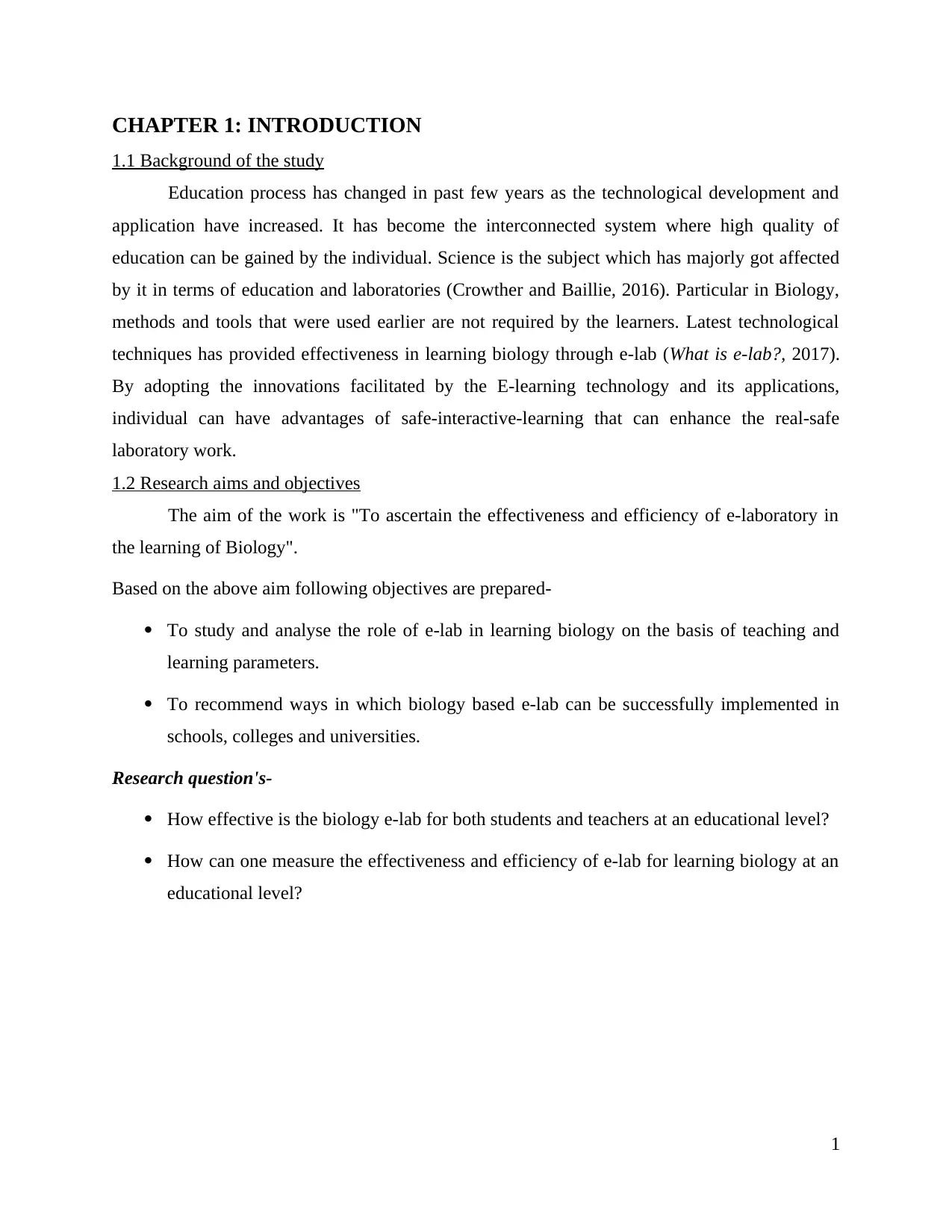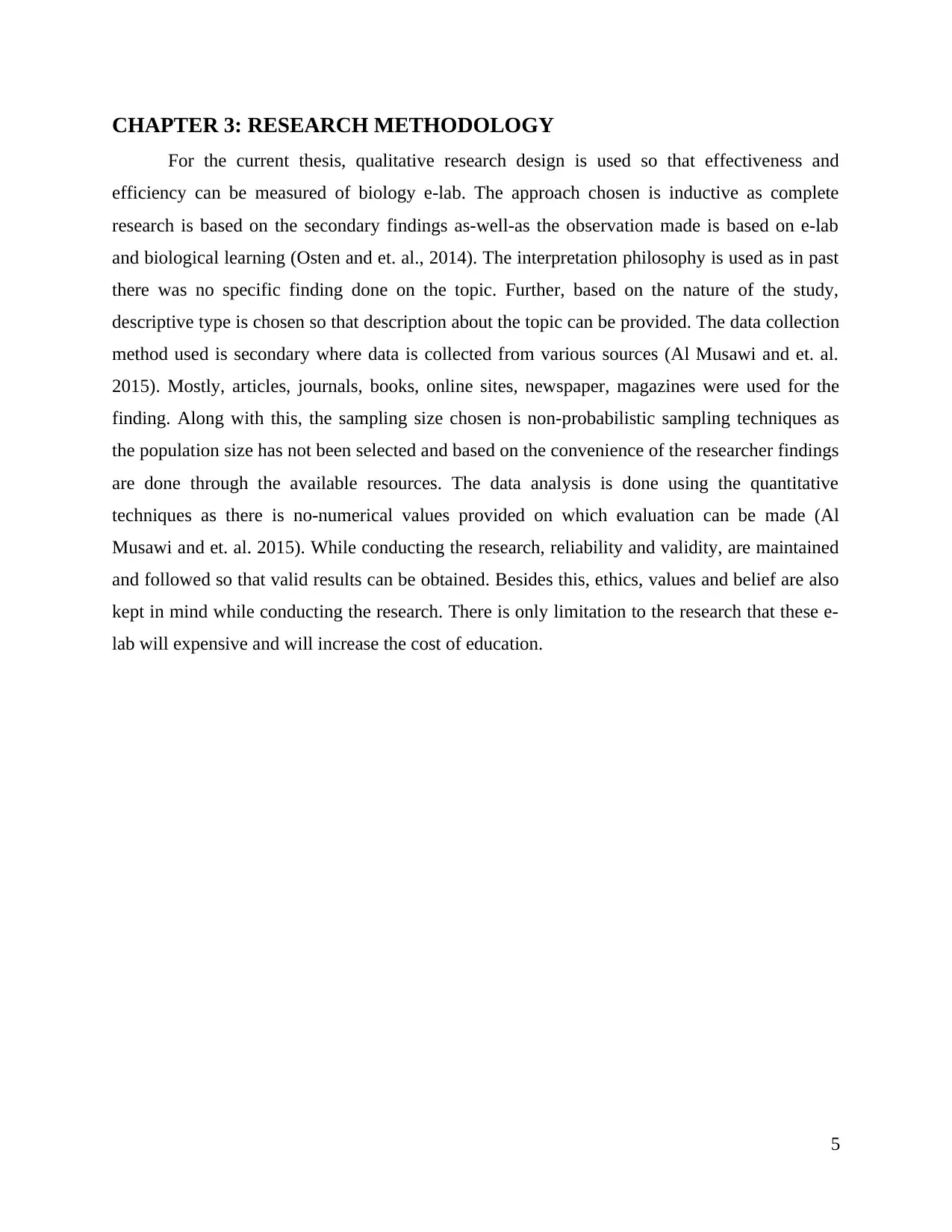The Role of E-laboratory in Enhancing Biology Learning Outcomes
VerifiedAdded on 2020/07/22
|10
|1778
|83
Report
AI Summary
This report investigates the effectiveness and efficiency of e-laboratories in biology education. It begins with an introduction outlining the background and objectives, followed by a literature review exploring the impact of technology on science education, particularly biology. The methodology section details the qualitative research design, inductive approach, and secondary data collection methods used. Data analysis focuses on the effectiveness of e-labs through the Pre-Post Test Control Group Design. The report concludes that e-biolabs can increase the effectiveness and efficiency of learning, offering collaborative environments and visualization capabilities. Recommendations are made for the adoption of e-Biolabs to enhance traditional learning systems.

Effect of E-laboratory in
Learning Biology
Learning Biology
Paraphrase This Document
Need a fresh take? Get an instant paraphrase of this document with our AI Paraphraser

TABLE OF CONTENTS
CHAPTER 1: INTRODUCTION....................................................................................................1
1.1 Background of the study...................................................................................................1
1.2 Research aims and objectives...........................................................................................1
CHAPTER 2: LITERATURE REVIEW.........................................................................................2
CHAPTER 3: RESEARCH METHODOLOGY.............................................................................5
CHAPTER 4: DATA ANALYSIS..................................................................................................6
CHAPTER 5: CONCLUSION AND RECOMMENDATION.......................................................7
REFERENCES................................................................................................................................8
ILLUSTRATION INDEX
Illustration 1: E-BioLab structure....................................................................................................2
Illustration 2: Grid structure and connectivity of the e-BioLab.......................................................3
Illustration 3: Application integration and brushing through E-BioLab..........................................5
CHAPTER 1: INTRODUCTION....................................................................................................1
1.1 Background of the study...................................................................................................1
1.2 Research aims and objectives...........................................................................................1
CHAPTER 2: LITERATURE REVIEW.........................................................................................2
CHAPTER 3: RESEARCH METHODOLOGY.............................................................................5
CHAPTER 4: DATA ANALYSIS..................................................................................................6
CHAPTER 5: CONCLUSION AND RECOMMENDATION.......................................................7
REFERENCES................................................................................................................................8
ILLUSTRATION INDEX
Illustration 1: E-BioLab structure....................................................................................................2
Illustration 2: Grid structure and connectivity of the e-BioLab.......................................................3
Illustration 3: Application integration and brushing through E-BioLab..........................................5

CHAPTER 1: INTRODUCTION
1.1 Background of the study
Education process has changed in past few years as the technological development and
application have increased. It has become the interconnected system where high quality of
education can be gained by the individual. Science is the subject which has majorly got affected
by it in terms of education and laboratories (Crowther and Baillie, 2016). Particular in Biology,
methods and tools that were used earlier are not required by the learners. Latest technological
techniques has provided effectiveness in learning biology through e-lab (What is e-lab?, 2017).
By adopting the innovations facilitated by the E-learning technology and its applications,
individual can have advantages of safe-interactive-learning that can enhance the real-safe
laboratory work.
1.2 Research aims and objectives
The aim of the work is "To ascertain the effectiveness and efficiency of e-laboratory in
the learning of Biology".
Based on the above aim following objectives are prepared-
To study and analyse the role of e-lab in learning biology on the basis of teaching and
learning parameters.
To recommend ways in which biology based e-lab can be successfully implemented in
schools, colleges and universities.
Research question's-
How effective is the biology e-lab for both students and teachers at an educational level?
How can one measure the effectiveness and efficiency of e-lab for learning biology at an
educational level?
1
1.1 Background of the study
Education process has changed in past few years as the technological development and
application have increased. It has become the interconnected system where high quality of
education can be gained by the individual. Science is the subject which has majorly got affected
by it in terms of education and laboratories (Crowther and Baillie, 2016). Particular in Biology,
methods and tools that were used earlier are not required by the learners. Latest technological
techniques has provided effectiveness in learning biology through e-lab (What is e-lab?, 2017).
By adopting the innovations facilitated by the E-learning technology and its applications,
individual can have advantages of safe-interactive-learning that can enhance the real-safe
laboratory work.
1.2 Research aims and objectives
The aim of the work is "To ascertain the effectiveness and efficiency of e-laboratory in
the learning of Biology".
Based on the above aim following objectives are prepared-
To study and analyse the role of e-lab in learning biology on the basis of teaching and
learning parameters.
To recommend ways in which biology based e-lab can be successfully implemented in
schools, colleges and universities.
Research question's-
How effective is the biology e-lab for both students and teachers at an educational level?
How can one measure the effectiveness and efficiency of e-lab for learning biology at an
educational level?
1
⊘ This is a preview!⊘
Do you want full access?
Subscribe today to unlock all pages.

Trusted by 1+ million students worldwide

CHAPTER 2: LITERATURE REVIEW
Due to advancement in technology and its integration with educational society has
developed the learning and teaching structure. It has redefined the educational process
component and has become the integral part of education. One of its application is in laboratories
where dangerous-and-difficult experiments can be easily performed on e-lab using simulation.
Biology is closely linked study of living organisms, conducting experiments and
laboratory work (Manchikanti, Kumar and Singh, 2016). Many researchers have identified that
positive attitude for the development of the skills and knowledge by performing the experiments.
There are various advantages which laboratories developers have observed using the e-laboratory
and computer application. According to the Lewis (2014), there are different types of e-lab that
are used for teaching biology such as 2D, 3D and online based labs. Moreover, there are various
tools used to find the effectiveness of these e-lab. These are achievement-test, attitudinal process
and scale towards biology, practical and visual skills and environmental scale which can aid
about the e-learning.
As stated by the Diwakar and et. al. (2011), there are various advantages of integrating
educational-software, scientific-technology and laboratory as it provides deep understanding
about the biological-topic, scientific-concepts and laboratory work and its applications in more
specified way.
2
Due to advancement in technology and its integration with educational society has
developed the learning and teaching structure. It has redefined the educational process
component and has become the integral part of education. One of its application is in laboratories
where dangerous-and-difficult experiments can be easily performed on e-lab using simulation.
Biology is closely linked study of living organisms, conducting experiments and
laboratory work (Manchikanti, Kumar and Singh, 2016). Many researchers have identified that
positive attitude for the development of the skills and knowledge by performing the experiments.
There are various advantages which laboratories developers have observed using the e-laboratory
and computer application. According to the Lewis (2014), there are different types of e-lab that
are used for teaching biology such as 2D, 3D and online based labs. Moreover, there are various
tools used to find the effectiveness of these e-lab. These are achievement-test, attitudinal process
and scale towards biology, practical and visual skills and environmental scale which can aid
about the e-learning.
As stated by the Diwakar and et. al. (2011), there are various advantages of integrating
educational-software, scientific-technology and laboratory as it provides deep understanding
about the biological-topic, scientific-concepts and laboratory work and its applications in more
specified way.
2
Paraphrase This Document
Need a fresh take? Get an instant paraphrase of this document with our AI Paraphraser

Illustration 1: E-BioLab structure
(Source: Rauwerda and et. al., 2007)
As mentioned by Diwakar and et. al. (2012), e-lab will provide advance devices and
equipment’s which traditional labs cannot provide. Through this, the data can be accessed from
any place using the software and simulation the process can be performed at faster rate. There
will be enhance in communication as well as their will less time consumed in performing the
experiments. It provides better advantage as compared to traditional laboratories such as students
can have direct experience, there will be less obstacles (Al Musawi and et. al., 2015). Moreover,
they will have interest in performing the experiments in interactive manner. It is safer to preform
and through unique visualization observation can be directly taken. There are various types of
technology that can be integrated with the laboratories practises.
3
(Source: Rauwerda and et. al., 2007)
As mentioned by Diwakar and et. al. (2012), e-lab will provide advance devices and
equipment’s which traditional labs cannot provide. Through this, the data can be accessed from
any place using the software and simulation the process can be performed at faster rate. There
will be enhance in communication as well as their will less time consumed in performing the
experiments. It provides better advantage as compared to traditional laboratories such as students
can have direct experience, there will be less obstacles (Al Musawi and et. al., 2015). Moreover,
they will have interest in performing the experiments in interactive manner. It is safer to preform
and through unique visualization observation can be directly taken. There are various types of
technology that can be integrated with the laboratories practises.
3

Illustration 2: Grid structure and connectivity of the e-BioLab
(Source: Rauwerda and et. al., 2007)
Previous studies: Al Musawi and et. al. (2015), performed the research through
experimental methods of the batch of 24 students and found that students provided positive
attitude towards application of biology e-lab.
4
(Source: Rauwerda and et. al., 2007)
Previous studies: Al Musawi and et. al. (2015), performed the research through
experimental methods of the batch of 24 students and found that students provided positive
attitude towards application of biology e-lab.
4
⊘ This is a preview!⊘
Do you want full access?
Subscribe today to unlock all pages.

Trusted by 1+ million students worldwide

CHAPTER 3: RESEARCH METHODOLOGY
For the current thesis, qualitative research design is used so that effectiveness and
efficiency can be measured of biology e-lab. The approach chosen is inductive as complete
research is based on the secondary findings as-well-as the observation made is based on e-lab
and biological learning (Osten and et. al., 2014). The interpretation philosophy is used as in past
there was no specific finding done on the topic. Further, based on the nature of the study,
descriptive type is chosen so that description about the topic can be provided. The data collection
method used is secondary where data is collected from various sources (Al Musawi and et. al.
2015). Mostly, articles, journals, books, online sites, newspaper, magazines were used for the
finding. Along with this, the sampling size chosen is non-probabilistic sampling techniques as
the population size has not been selected and based on the convenience of the researcher findings
are done through the available resources. The data analysis is done using the quantitative
techniques as there is no-numerical values provided on which evaluation can be made (Al
Musawi and et. al. 2015). While conducting the research, reliability and validity, are maintained
and followed so that valid results can be obtained. Besides this, ethics, values and belief are also
kept in mind while conducting the research. There is only limitation to the research that these e-
lab will expensive and will increase the cost of education.
5
For the current thesis, qualitative research design is used so that effectiveness and
efficiency can be measured of biology e-lab. The approach chosen is inductive as complete
research is based on the secondary findings as-well-as the observation made is based on e-lab
and biological learning (Osten and et. al., 2014). The interpretation philosophy is used as in past
there was no specific finding done on the topic. Further, based on the nature of the study,
descriptive type is chosen so that description about the topic can be provided. The data collection
method used is secondary where data is collected from various sources (Al Musawi and et. al.
2015). Mostly, articles, journals, books, online sites, newspaper, magazines were used for the
finding. Along with this, the sampling size chosen is non-probabilistic sampling techniques as
the population size has not been selected and based on the convenience of the researcher findings
are done through the available resources. The data analysis is done using the quantitative
techniques as there is no-numerical values provided on which evaluation can be made (Al
Musawi and et. al. 2015). While conducting the research, reliability and validity, are maintained
and followed so that valid results can be obtained. Besides this, ethics, values and belief are also
kept in mind while conducting the research. There is only limitation to the research that these e-
lab will expensive and will increase the cost of education.
5
Paraphrase This Document
Need a fresh take? Get an instant paraphrase of this document with our AI Paraphraser

CHAPTER 4: DATA ANALYSIS
As the complete study was based on the secondary data collection, so it can be analysed
that the effectiveness can be carried out through the Pre-Post Test Control Group Design
(Ecaterina and Roxana-Elena (2012). Here biology experiments should be performed by the
teachers using e-lab. Moreover, Rauwerda and et. al. (2007) in their article have mentioned about
the development of e-BioScience laboratories for learning biology. They have mentioned the
ways that can be adopted at the school level and at other places. Along with this, they also stated
about the issues faced and the opportunities they have received. They have connected the e-
Biolabs with other existing universities so that more information can be transferred in easy ways.
Il
lustration 3: Application integration and brushing through E-BioLabs
(Source: Rauwerda and et. al., 2007)
6
As the complete study was based on the secondary data collection, so it can be analysed
that the effectiveness can be carried out through the Pre-Post Test Control Group Design
(Ecaterina and Roxana-Elena (2012). Here biology experiments should be performed by the
teachers using e-lab. Moreover, Rauwerda and et. al. (2007) in their article have mentioned about
the development of e-BioScience laboratories for learning biology. They have mentioned the
ways that can be adopted at the school level and at other places. Along with this, they also stated
about the issues faced and the opportunities they have received. They have connected the e-
Biolabs with other existing universities so that more information can be transferred in easy ways.
Il
lustration 3: Application integration and brushing through E-BioLabs
(Source: Rauwerda and et. al., 2007)
6

CHAPTER 5: CONCLUSION AND RECOMMENDATION
From the report, it can be concluded that the e-biolabs will effectively increase the
effectiveness and efficiency of the learning made by the students. Moreover, it will provide
better collaborative working environment and multidisciplinary project can be completed in easy
ways. Additionally, the outcomes can be mentioned through the visualization capabilities and
using the capture methods to others. It can be recommended that the effectiveness and efficiency
will probably increase then the traditional system and e-Biolabs shown by Rauwerda and et. al. it
should be defiantly adopted by other areas.
7
From the report, it can be concluded that the e-biolabs will effectively increase the
effectiveness and efficiency of the learning made by the students. Moreover, it will provide
better collaborative working environment and multidisciplinary project can be completed in easy
ways. Additionally, the outcomes can be mentioned through the visualization capabilities and
using the capture methods to others. It can be recommended that the effectiveness and efficiency
will probably increase then the traditional system and e-Biolabs shown by Rauwerda and et. al. it
should be defiantly adopted by other areas.
7
⊘ This is a preview!⊘
Do you want full access?
Subscribe today to unlock all pages.

Trusted by 1+ million students worldwide

REFERENCES
Books and Journals
Rauwerda, H. and et. al., 2007. The role of e-BioLabs in a life sciences collaborative working
environment. In Proceedings of eChallenges (Vol. 2007).
Crowther, E. and Baillie, S., 2016. A method of developing and introducing case‐based learning
to a preclinical veterinary curriculum. Anatomical sciences education. 9(1). pp.80-89.
Manchikanti, P., Kumar, B. R. and Singh, V. K., 2016, December. Role of Virtual Biology
Laboratories in Online and Remote Learning. In Technology for Education (T4E), 2016
IEEE Eighth International Conference on (pp. 136-139). IEEE.
Lewis, D.I., 2014. The pedagogical benefits and pitfalls of virtual tools for teaching and learning
laboratory practices in the biological sciences. The Higher Education Academy: STEM.
Diwakar, S. and et. al., 2011. Enhanced facilitation of biotechnology education in developing
nations via virtual labs: analysis, implementation and case-studies. International Journal
of Computer Theory and Engineering. 3(1). p.1.
Diwakar, S. and et. al., 2012. Biotechnology Virtual Labs: facilitating laboratory access anytime-
anywhere for classroom education. In Innovations in biotechnology. InTech.
Al Musawi A. and et. al., 2015. Effectiveness Of E-Lab Use In Science Teaching At The Omani
Schools. TOJET: The Turkish Online Journal of Educational Technology. 14(1).
Ecaterina, B. R. and Roxana-Elena, A., 2012. Perception Of E-learning Among University
Students. Ovidius University Annals, Series Economic Sciences. 12(2).
Osten, W. and et. al., 2014. Recent advances in digital holography. Applied optics. 53(27).
pp.G44-G63.
Online
What is e-lab?, 2017. [Online]. Available through:
<https://www.ncbi.nlm.nih.gov/pmc/articles/PMC423136/>. [Accessed on 14th
September 2017].
8
Books and Journals
Rauwerda, H. and et. al., 2007. The role of e-BioLabs in a life sciences collaborative working
environment. In Proceedings of eChallenges (Vol. 2007).
Crowther, E. and Baillie, S., 2016. A method of developing and introducing case‐based learning
to a preclinical veterinary curriculum. Anatomical sciences education. 9(1). pp.80-89.
Manchikanti, P., Kumar, B. R. and Singh, V. K., 2016, December. Role of Virtual Biology
Laboratories in Online and Remote Learning. In Technology for Education (T4E), 2016
IEEE Eighth International Conference on (pp. 136-139). IEEE.
Lewis, D.I., 2014. The pedagogical benefits and pitfalls of virtual tools for teaching and learning
laboratory practices in the biological sciences. The Higher Education Academy: STEM.
Diwakar, S. and et. al., 2011. Enhanced facilitation of biotechnology education in developing
nations via virtual labs: analysis, implementation and case-studies. International Journal
of Computer Theory and Engineering. 3(1). p.1.
Diwakar, S. and et. al., 2012. Biotechnology Virtual Labs: facilitating laboratory access anytime-
anywhere for classroom education. In Innovations in biotechnology. InTech.
Al Musawi A. and et. al., 2015. Effectiveness Of E-Lab Use In Science Teaching At The Omani
Schools. TOJET: The Turkish Online Journal of Educational Technology. 14(1).
Ecaterina, B. R. and Roxana-Elena, A., 2012. Perception Of E-learning Among University
Students. Ovidius University Annals, Series Economic Sciences. 12(2).
Osten, W. and et. al., 2014. Recent advances in digital holography. Applied optics. 53(27).
pp.G44-G63.
Online
What is e-lab?, 2017. [Online]. Available through:
<https://www.ncbi.nlm.nih.gov/pmc/articles/PMC423136/>. [Accessed on 14th
September 2017].
8
1 out of 10
Related Documents
Your All-in-One AI-Powered Toolkit for Academic Success.
+13062052269
info@desklib.com
Available 24*7 on WhatsApp / Email
![[object Object]](/_next/static/media/star-bottom.7253800d.svg)
Unlock your academic potential
Copyright © 2020–2025 A2Z Services. All Rights Reserved. Developed and managed by ZUCOL.





